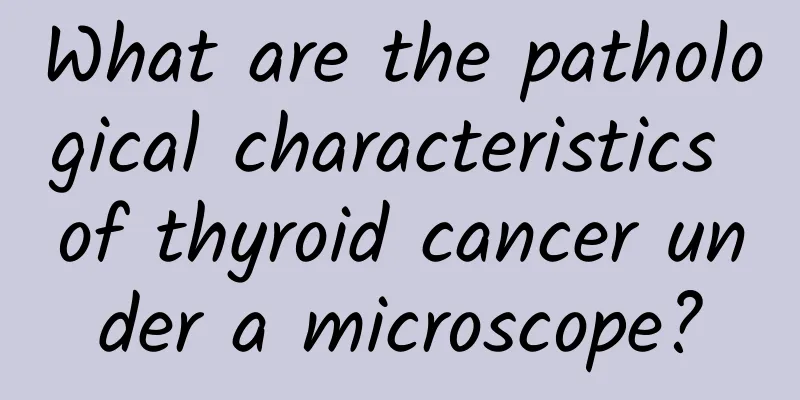What are the pathological characteristics of thyroid cancer under a microscope?

|
Author: Zhang Jinxia, Chief Physician, Peking University Shougang Hospital Reviewer: Wu Xueyan, Chief Physician, Peking Union Medical College Hospital The thyroid gland is a very important endocrine organ in the human body. It is shaped like a butterfly and is attached to both sides of the trachea. The right lobe is called the right lobe, and the left lobe is called the left lobe. Figure 1 Original copyright image, no permission to reprint As people's living standards improve and their health awareness increases, more and more people are undergoing regular physical examinations. Many friends will be diagnosed with thyroid nodules during thyroid screening. Thyroid nodule is a clinical diagnosis, which means that something grows on the thyroid gland. This thing can be round or irregular; it can be inflammatory or tumorous; it can be a cyst or a cystic-solid complex, and so on. For patients diagnosed with thyroid nodules, there is no need to be too nervous, because only 5% of thyroid nodules are thyroid cancer. Under the microscope, the thyroid gland is composed of thyroid follicular epithelial cells, neuroendocrine cells, and stroma such as lymph, blood vessels, and nerves. We usually say that thyroid cancer originates from the follicular epithelial cells and neuroendocrine cells of the thyroid gland. From a pathological perspective, thyroid cancer is divided into papillary thyroid cancer, follicular thyroid cancer, medullary thyroid cancer, and anaplastic thyroid cancer. Among these types, papillary thyroid cancer accounts for the highest proportion, about 70%-80%, follicular cancer accounts for about 10%, medullary cancer accounts for 5%-10%, and the rarest is anaplastic thyroid cancer. Anaplastic cancer has the highest malignancy and the worst prognosis, while papillary cancer and follicular cancer have the lowest malignancy and the best prognosis, and medullary cancer is in between. For different types of thyroid cancer, their characteristics under the microscope are different during pathological examination. Papillary thyroid cancer: Normal thyroid tissue is like beef, while papillary carcinoma is grayish white, hard, and feels gritty when cut, like cutting a pear. Under the microscope, we can see that papillary thyroid carcinoma forms many branched papillae, each of which has fibrous blood vessels in the center and is covered with follicular epithelium. The cells of papillary carcinoma are very distinctive. Under the microscope, the nucleus is transparent and appears frosted glass; there is overlap between the nuclei, and nuclear grooves can be seen; the cytoplasm is invaginated, forming red inclusion bodies in the nucleus; small, blue calcified bodies can be seen in the interstitium, so it feels like gravel when cut. Figure 2 Original copyright image, no permission to reprint Follicular Thyroid Cancer: Thyroid follicular carcinoma is often gray-red or gray-white, with a delicate texture like fish meat, with clear boundaries from the surrounding areas, and no gritty feeling when cut. Under the microscope, it is composed of a large number of well-differentiated follicles. This follicular structure is sometimes difficult to distinguish from normal follicles. We have to judge whether it is malignant by seeing whether it has invasion of the capsule and blood vessels. If it extends out and involves the capsule, or there is a tumor thrombus in the blood vessels, it is a very important feature of follicular carcinoma. Medullary Thyroid Cancer: The cancerous tissue of medullary thyroid carcinoma is also grayish white and hard to the naked eye. Under the microscope, the cancer cells are often groove-like, beam-like, and sometimes appear as small follicles. Its characteristic is the presence of red-stained amyloid deposits in the interstitium. In addition, patients may have elevated thyroid calcitonin and some clinical symptoms, which originate from neuroendocrine cells. Anaplastic thyroid cancer: Under the microscope, the cells are very abundant and the cell atypia is relatively large. They may appear as spindle-shaped sarcomas. In some places, giant cells can be seen, and residual remnants of thyroid follicular carcinoma or papillary carcinoma can be seen in the periphery. Anaplastic thyroid cancer is the most malignant of all thyroid cancer types and is very invasive. However, this type is relatively rare and can achieve a relatively good prognosis if discovered in time and treated actively. |
<<: Several major factors that affect glycosylated hemoglobin, are you affected?
>>: Thyroid puncture biopsy pathology report - interpretation of common terms!
Recommend
Can I eat goose eggs during early pregnancy?
Goose eggs are a type of egg food that is not com...
I have had oil in my urine for seven years.
Is it important to have oil droplets in women'...
There is almost no menstrual period in the first three days
Although irregular menstruation is a common condi...
What to do if you have bleeding one week after your period ends
Many women experience abnormal phenomena after th...
What to eat to increase progesterone levels
For pregnant women, progesterone level is an impo...
[Women's Health] What are the effects and functions of drinking royal jelly for women?
Everyone knows that honey is an excellent nutriti...
When is the best time to plant ginger? How to prevent ginger diseases and pests
Ginger is a very common seasoning vegetable in ou...
A brief discussion on the best months for pregnant women to eat walnuts
Pregnant women are a group that we need to take g...
Can I still get pregnant even if I wear a condom?
For pregnant women, better recovery is not only l...
Tuberculosis science: Why do you need to take a chest X-ray after coughing for two weeks?
1. What is tuberculosis? Tuberculosis (TB) is a c...
Causes of lumbar pain in women
Nowadays, the competition in society is getting m...
Woman wakes up with back pain
It is also common for women to feel back pain whe...
Can I have sex if my menstrual period is not clean?
As long as the menstruation has not completely en...
Uterine prolapse pictures
For every woman, the uterus is an important part ...









